When I have the opportunity to visit someone who has fencing memorabilia that I can scan for my collection, I often don’t get a chance to thoroughly take in the significance of everything I’m working with. I work fast, replacing one item from the flatbed scanner as soon as the scan is done, dropping another item down to replace it and setting up the next scan. So when I get a chance to go back and look, I’ll have that moment of revelation, thinking, “Boy, am I glad I scanned that piece!” That’s definitely how I came across today’s topic. The small section at the top of the page is only a tease for the astonishing evening performance that the Los Angeles Athletic Club held on January 3rd, 1936.
The evening’s program for what was apparently an annual event at the LAAC. Billed as “the opening of the 1936 Olympic fencing season”, this Friday evening certainly provided the goods. Among the 25 events for the evening, four past Olympians participated in seven of the events, including 1928 Olympic Gold Medalist Helene Mayer.
This handbill is from the fantastic collection of memorabilia that I was able to scan thanks to the generosity of the family of 1936 and 1948 Olympian Andrew Boyd. (See more about Boyd and my visit to the Owens Valley here.) As per usual, I ran across this piece while looking for something else. I’m in the process of trying to track down information about a fencing book written by Boyd’s coach, Henri Uyttenhove. While reviewing my Uyttenhove material, I took a look at this program and became enthralled with the wide variety of fencers involved in this evening of entertainment. As I ran down the list of participants, I thought it would be fun to give a bit of a play-by-play of the folks I can identify. So I’ll work from the top down and talk story about the players.
The first four events, clearly the preliminary rounds, are handled by folks who’s names are entirely unfamiliar. I haven’t tried to go through what little documentation exists from this era. The tournaments these fencers can lay their claims of victory for wouldn’t be likely to show up. There isn’t much info to go through. So just some names of once-upon-a-time fencers who didn’t have a great impact upon the sport. When we get to #5, we have a ‘known’ name.
This photo, courtesy of Andy Shaw at the Museum of American Fencing, shows Edith Jane, later Edith Jane Faulkner, on the left performing at a some Hollywood event or other. Capable of winning the Pacific Coast Women’s Foil title when Helene Mayer was otherwise occupied, Edith Jane was better known as the dance instructor at the Falcon Studios space she shared with fencing instructor/Olympic fencer/actor/fight choreographer/future husband Ralph Faulkner. I haven’t been able to ID the other woman in the photo. And what swashbuckler movie premier were they helping promote? No idea. This was taken in the courtyard of Sid Grauman’s Chinese Theater. Edith’s front foot is planted squarely on Eddie Cantor.
After an epee bout, we get to a couple of the more curious inclusions in the program. First is an exhibition of cavalry sabres, followed by a demonstration of kendo. In 1936, Torao Mori had not yet arrived in Los Angeles to teach kendo and learn Western fencing from Henri Uyttenhove at the LAAC, but LA already had a well-established tradition of kendo in the local Japanese community. After the kendo, the first of the Olympians takes the stage.
Duris de Jong was a two-time Olympic team member for the Netherlands, competing in 1928 and 1932. Interestingly, the Netherlands didn’t send anything like a complete team to Los Angeles in 1932. However, de Jong was already living in LA. Since he’d competed in 1928, he applied to the Netherlands Olympic Committee to be allowed to hop on the Red Car heading down to Exposition Park and step onto the team. Since there was no cost to consider and he was a past Olympian, it was an easy decision to give him the green light. He went out in the Semi-Finals of the Men’s Foil individual, dropping all his bouts in a pool of nine. Of interest to me, in 1928 in the Men’s Foil Team event, he won a 5-3 decision in a bout against György Piller of Hungary. Piller fenced in both Team Foil and Team Epee in 1928, which was the year before he began his domination in sabre. Piller’s record in his two 1928 events was 4 wins, 15 losses. Compare that to his dominance in sabre at the 1932 Games, where he finished 30-2.
Duris de Jong’s first foil bout is against DeLoss McGraw. McGraw is a name I’ve run across before, and I imagine he gave a good account of himself against the two-time Olympian. The next match, #10, is a very intriguing matchup, pitting 1932 Olympian Harold “Hal” Corbin against up and coming fencer and Hollywood professional Edward Carfagno. There is a great interview with Corbin you can check out here where he talks about his 1932 Olympic experience – and suggests that if they were still using point d’arret in the LA Olympics of 1984 he’d still have been good for a few touches against the youngsters.
Hal Corbin in the center, just to the left of UCLA coach John Duff, who is a whole story on his own. There aren’t many photos of Corbin that I’ve run across so far. He had a long fencing life in Southern Cal and won a lot of tournaments.
Corbin’s opponent in his epee bout is Edward Carfagno, a two-weapon threat in foil and epee who finished 2nd in foil at the 1939 US National Championships that were held on Treasure Island in San Francisco. Carfagno was named to the 1940 Olympic foil team, but of course that Olympics never took place due to the turbulence of war throughout Europe and Asia. Fencing was not what Carfagno was best known for, however. He was a three-time Academy Award winning Art Director, probably best known for his work on Ben Hur (1959), but he also worked on the original Twilight Zone TV series.
After some foil, sabre and Balloon Sabre bouts (don’t know, can’t explain) we arrive at match numbers 14 & 15. The first features Fred Linkmeyer in an epee match against Navy pilot Doughty. I don’t know a lot about Doughty, but I’ve seen notices where his presence at tournaments in both Southern Cal and Northern Cal were dependent upon the weather and his schedule. An active duty Navy pilot, he was known to fly up to Nor Cal for tournaments when he had a chance. Linkmeyer was a perennial finalist in the Pacific Coast Championships, multi-time National finalist in epee and a dedicated administrator for the sport.
A cover photo from the in-house magazine from the LAAC. Left to right, Fred Linkmeyer, Edward Carfagno and Andrew Boyd.
Linkmeyer and Doughty are followed by Faulkner and Carfagno in a sabre match. Faulkner, like de Jong, was on the 1928 and 1932 Olympic teams. In 1928 Faulkner never got on the strip, the East Coast hegemony in charge determining that he didn’t have the quality to match up on the international scene. Maybe they were right, but in 1932, in his only Olympic bouts, up against the soon-to-be-gold-medal-winning Hungarian team, Faulkner went 2-2 with the rest of the US squad winning only one other bout against Piller & Co. So there that is.
The next match is particularly curious. Fight choreographer and fencing master Fred Cavens puts on a “Exhibition Bout” with a member of the Hollywood Athletic Club. Was it a choreographed show-piece? Did they fence a serious match?
Fred Cavens at work. In this publicity pose, Cavens goes toe-to-toe with Captain Blood’s arch foe, Levasseur, also known as Basil Rathbone. Cavens did a ton of work in Hollywood. He was the frequent target of Aldo Nadi, once he arrived on the Hollywood scene, who considered Cavens the archetype of fencing master Hollywood used in lieu of those who knew fencing better. Such as Aldo Nadi. It’s entirely possible that Cavens was easier to get along with on set.
Cavens did not often venture beyond his Hollywood bubble, so it’s difficult to assess his skill as a fencing master. He did not, to the best of my knowledge, produce competitors. I’m not sure he even attempted to. With scads of film credits to his name ranging from 1920 to 1962, it’s quite possible he didn’t have time to bother with competitive fencing. He trained in Belgium, graduating with a degree from the Military Institute of Physical Education and Fencing, so it would seem that, competitive experience or not, he had a decent idea of what he was doing. In looking at his list of credits, he was involved in some of the greatest swashbucklers of all time, including the aforementioned Captain Blood where Peter Blood goes toe to toe against the dastardly Levasseur (see above) on the beach. That alone would put him on the list of great fight choreographers. However, he also did the choreography work for Disney’s Zorro TV show, so I owe him a great debt for instilling in me a love for flashy swordplay.
Cavens is followed by a dagger and epee match. That may sound strange to us today, but it was quite a rage back in the 20s & 30s. There’s YouTube footage of Aldo Nadi fencing with sword and dagger that you can see here. He taught this sort of fencing in France prior to crossing the ocean to New York.
After that, another exhibition of kendo, followed by a foil lesson with Henri Uyttenhove teaching and Helene Mayer as pupil. I’d love to be able to share a YouTube clip of that, but alas, no such luck.
Clearly Uyttenhove was familiar with the local kendo scene. That’s him on the left, using a sabre against a shinai. The people watching include H. G. Feraud, in the headband, who served as the master of ceremonies for this 1936 fencing spectacular.
After another sabre bout, a demonstration of sharp Japanese swords. It’s possible that the kendo guy up against Uyttenhove above is the same that put on this portion of the event, but there are spelling and legibility issues with the note on the back of the press photo above. So I can’t be sure.
When we get to #23, we have Ralph Faulkner up against John Ely. Faulkner was still representing the LAAC at this point in time which is interesting, but not as interesting as John Ely representing Victor McLaglen’s Light Horse Regiment. “What the hell?” you say? You read that correctly. Wikipedia describes it as a “riding parade club, a polo-playing group and a precision motorcycle contingent”. Founded by actor Victor McLaglen.
My all time favorite character actor Victor McLaglen, seen above with Cary Grant. McLaglen was a soldier and boxer before turning to a career in Hollywood. He’s got 124 credits listed on IMDB, so if you don’t know who he is you don’t watch enough movies.
McLaglen’s horse riding, polo playing, motorcycle trick riding club was a social organization that was for a short time wrongly accused of having facist leanings. Polo was one of the most popular of Hollywood elite pastimes, with players like Spencer Tracy, Clark Gable and Walt Disney. McLaglen’s group played polo and participated in local parades. I’m guessing they may have been seen in the granddaddy of SoCal parades, the Rose Parade, but I don’t really know. Surprisingly, the motorcycle wing is still in existence and still sporting McLaglen’s name. Go figure! This doesn’t help me figure out who John Ely was and why he was representing McLaglen’s group at a fencing exhibition. Nothing related to McLaglen’s group mentions anything about fencing, so perhaps Ely put them as his representative club as a bit of lark.
The final foil bout of the evening is an exhibition of foil mastery put on by Helene Mayer and Duris de Jong.
This article is from a few years before. 1934, I think. Helene Mayer did not often lose bouts on the west coast. It’s possible she never lost a bout on the west coast.
Because it was handy and I also did some photoshop work to clean this image up from some of the paint work done to get it ready for newspaper publication, I thought I’d add another Helene Mayer photo. In this one, she’s sporting an LAAC patch, the club she represented during her college days. She attended the Claremont Colleges in Claremont, CA, the next town over from my hometown of Pomona.
I’d love to know how Duris de Jong fared in a bout against Helene Mayer. By 1936 de Jong was doing more teaching than competing, while Helene was still waiting to learn if she would or would not represent her native Germany at the 1936 Berlin Olympics. She did, but that’s a story all its own.
The final event of the evening must have been a rousing and crowd-pleasing affair. They had demonstrated it earlier in the evening – the Balloon Sabre event – but for the grand finale, they use a team format. Now, there’s no way to know if they used a one-bout-at-a-time format, or a melee format. I’d like to imagine the latter. That is undoubtedly due to my having seen this:
As fun as that is, I just can’t end there. Fortunately, I have just the picture to wrap all this up.
The above training session took place in the run-up to the 1932 Los Angeles Olympic Games. From left to right, Duris de Jong, H. G. Feraud and Ralph Faulkner. All three participated in the 1936 LAAC Gala Assault, two as fencers, one as master of ceremonies. All things considered, this would have been quite the spectacle to witness. One of these days I still hope to get down to the Los Angeles Athletic Club to go through their archives. This event is certainly one I’ll put on my list for researching. Who knows? Maybe they’ve got other documentation or photographs. I despair of any film footage, of course. Can’t hope for too much.


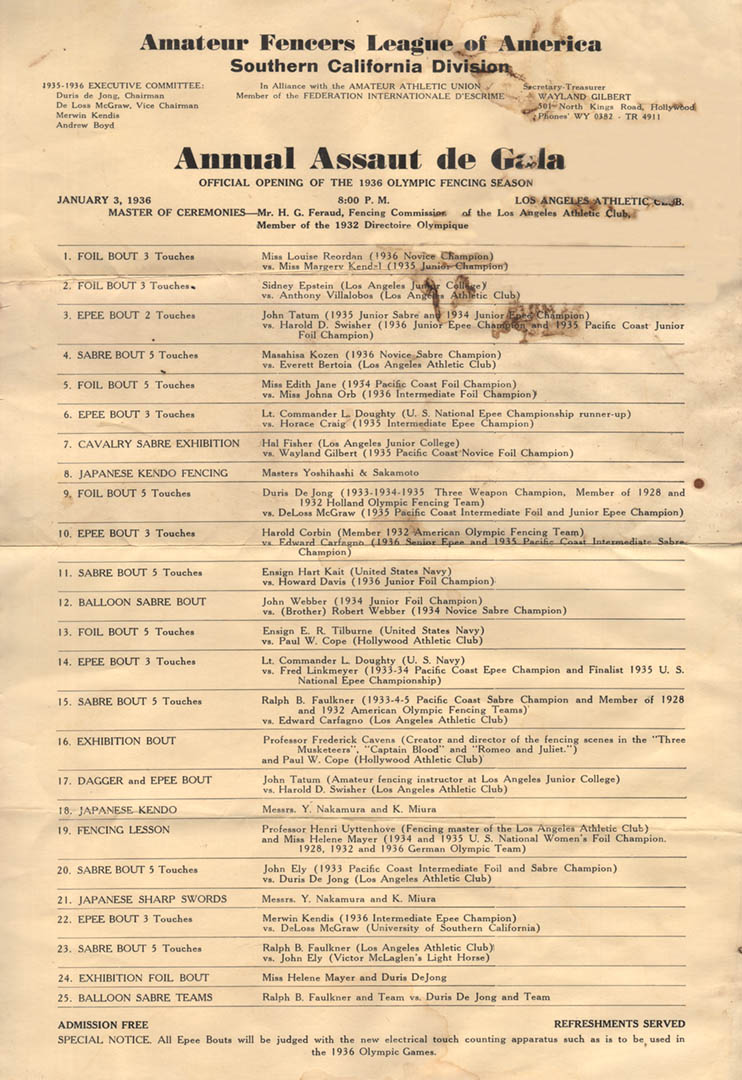
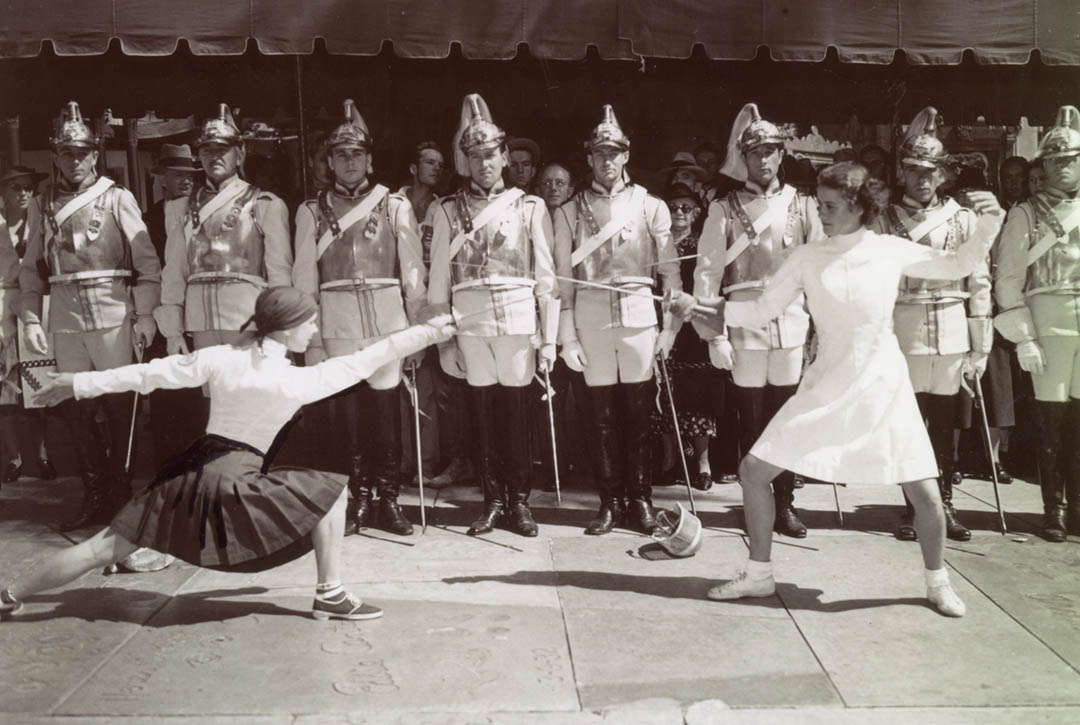

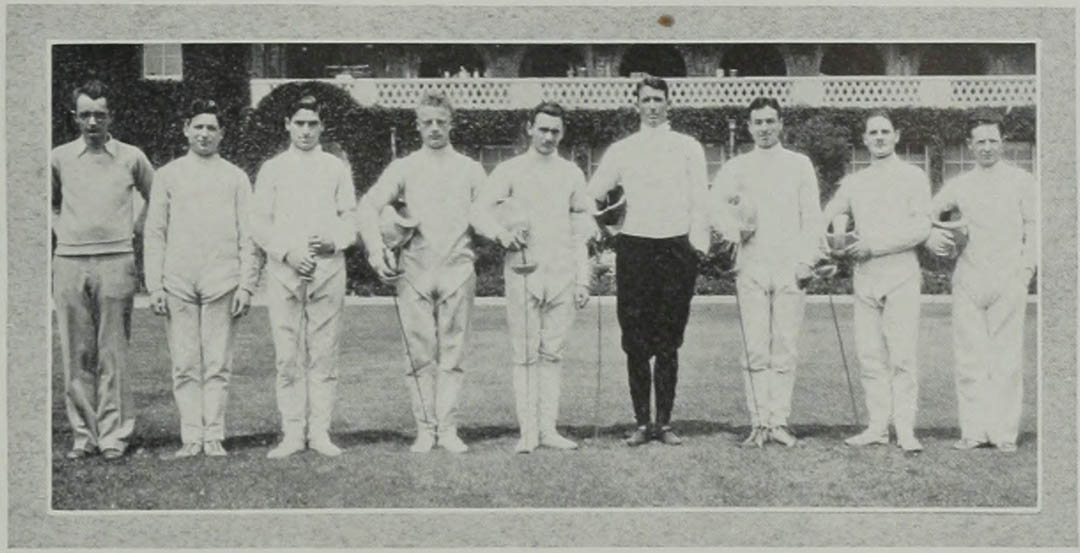
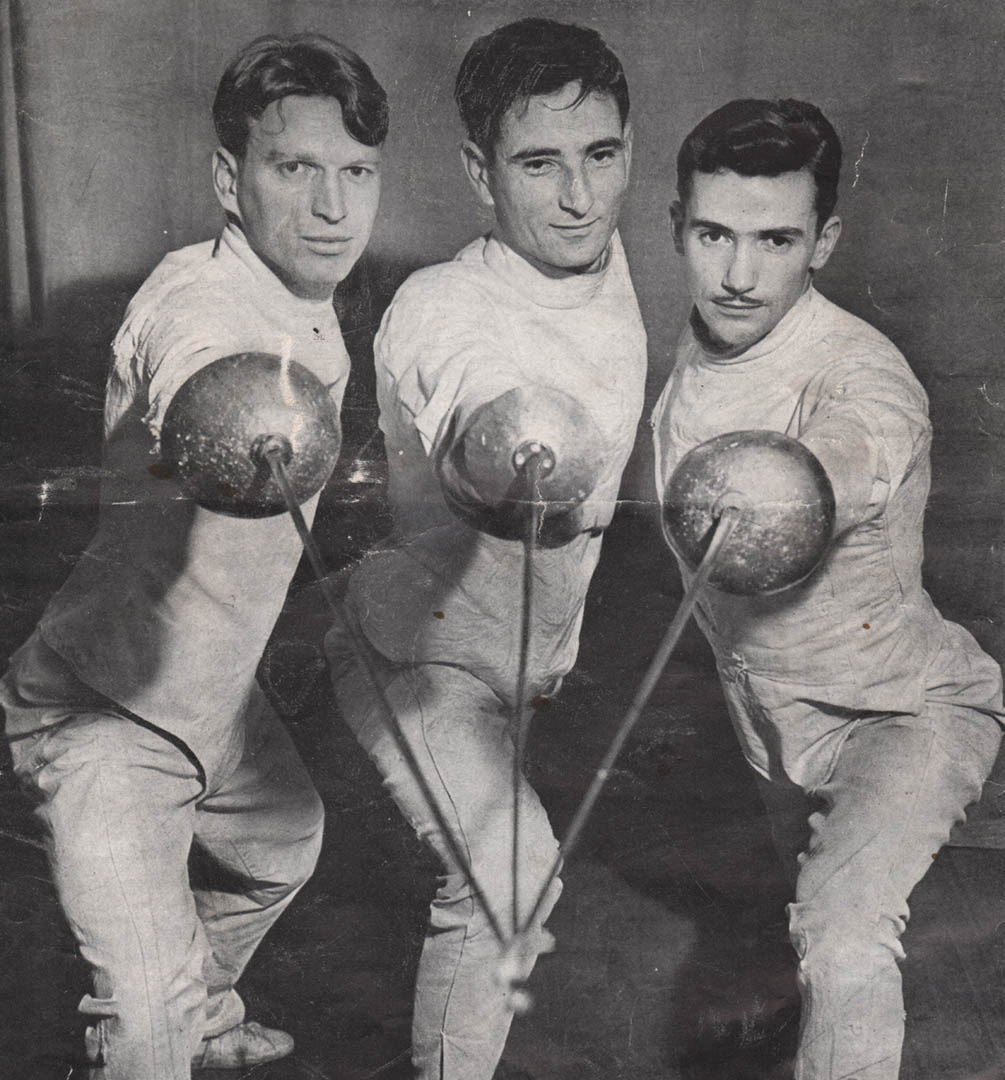
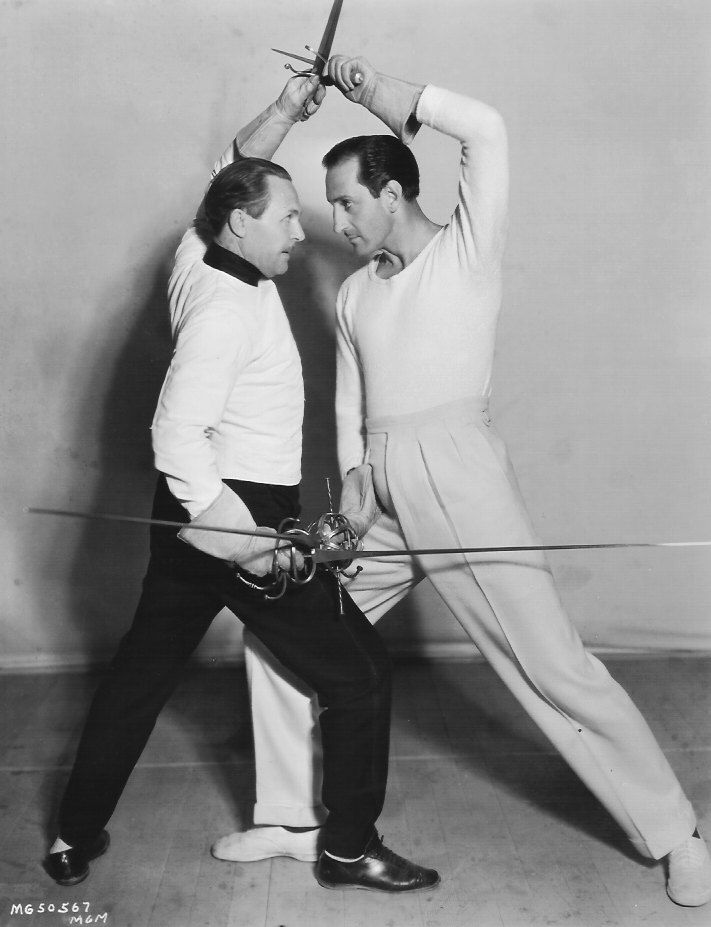
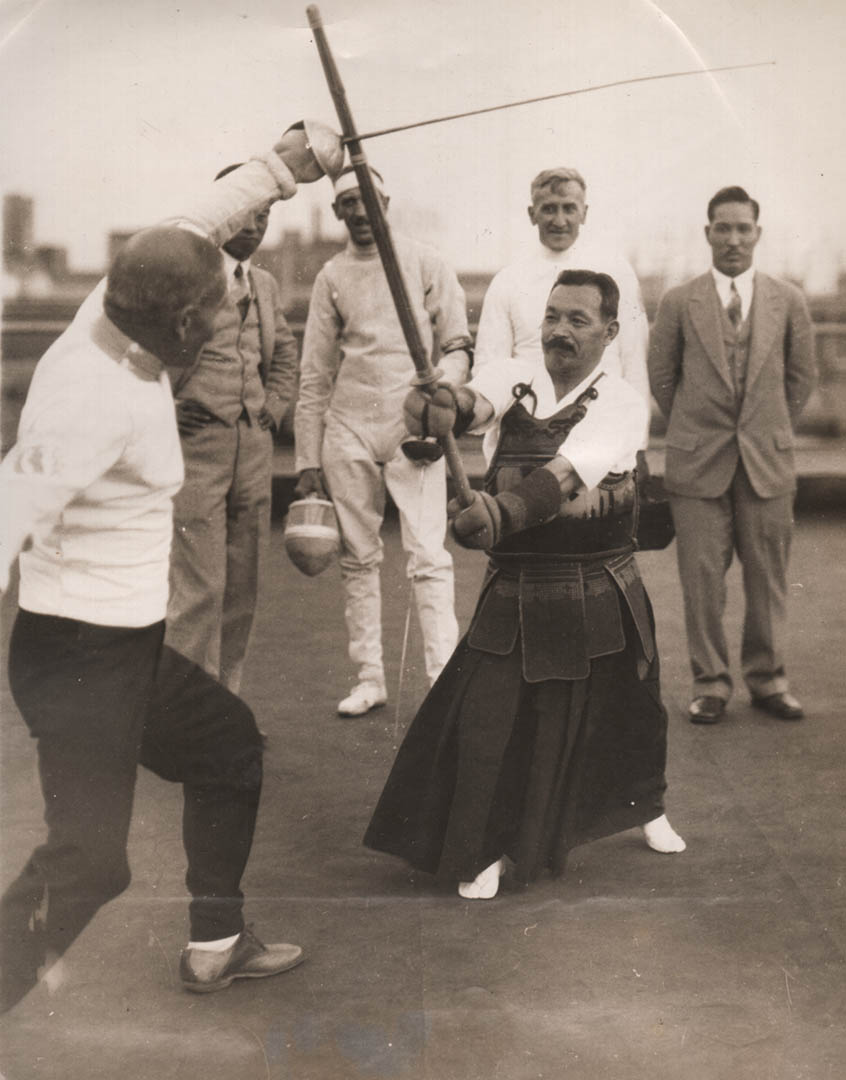
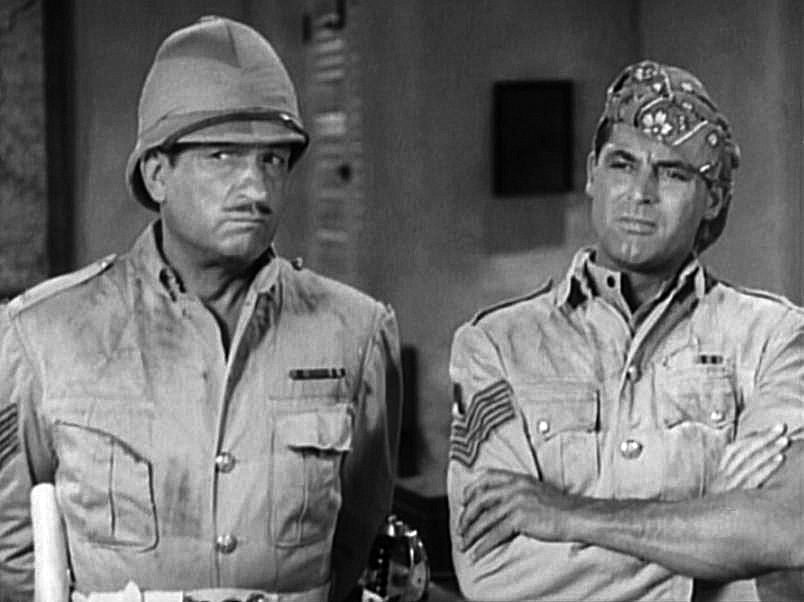
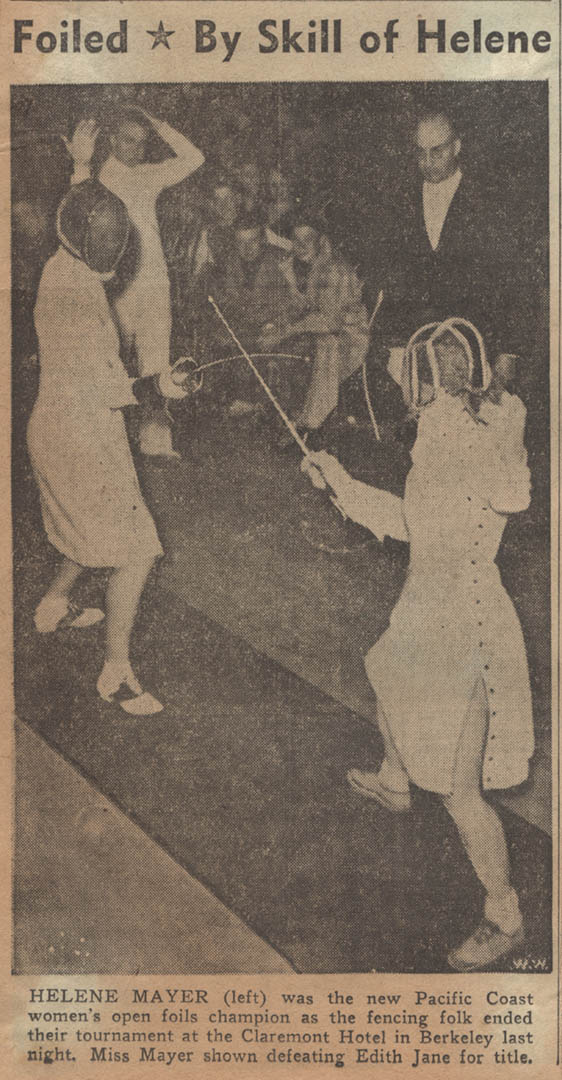
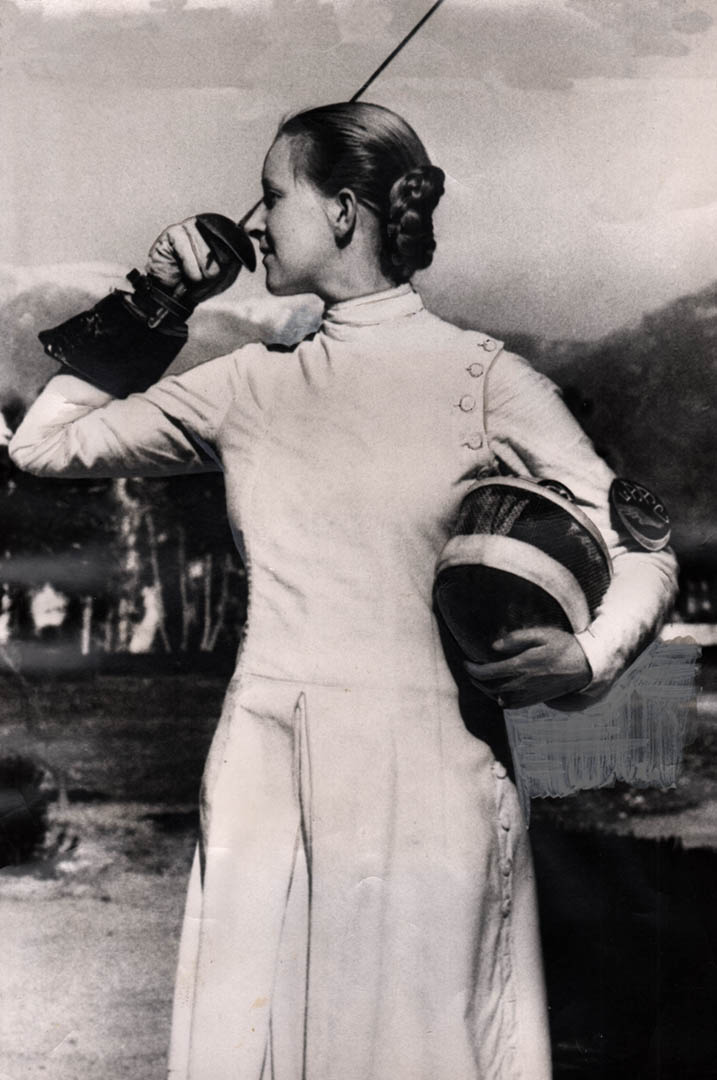
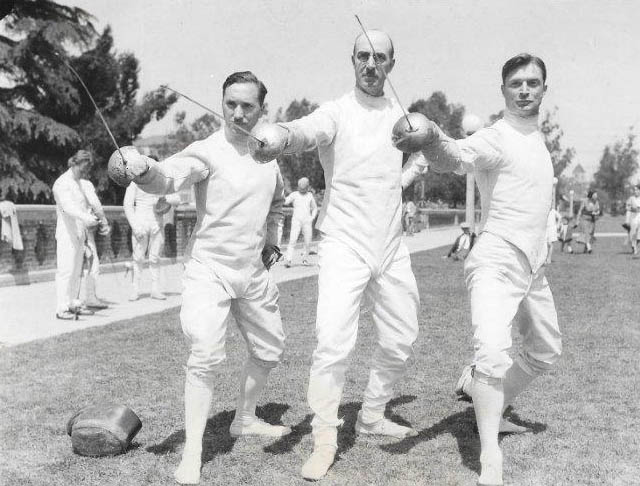
Did a little digging on Lt. Commander Leonard Doughty. He fenced at the Naval Academy and was a finalist at the All Eastern Championships in 1939. At the time of this 1936 event, he was a gunnery officer on the battleship Mississippi which was on Pacific Ocean duty at the time. In the May, 1940 edition of The Riposte magazine, in an article announcing the National Championships to be held in New York, I found this sentence: “Lieut. Commander Leonard Doughty plans to fly from the Pacific Coast to represent the Navy at Large.” In another search hit, I found a note from a fellow Naval officer, John Carmichael, who wrote how Doughty made sure to get Carmichael posted to the Mississippi as Doughty wanted someone to fence with. They would attend tournaments and go to fencing clubs together when in the Port of San Francisco for Fleet Week.
The photo of Edith Jane in front of Grauman’s Chinese Theatre was taken on Oct. 6, 1937 at the opening for The Prisoner of Zenda (in which, Edith’s husband did a little sword fighting). The other fencer in the photo is Louise Reordan. Edith and Louise earned their spots in the ceremony by finishing first and second in a competition on the previous day. In addition to the film’s opening, this was also the event where Hollywood and Culver City “buried the hatchet,” quite literally, on a long running dispute over which city had rights to the name “Hollywood.” In a ceremony attended by officials from both cities as well as the governor of California, a hatchet was dropped into some wet cement and that was that. I assume it’s still there to this day.